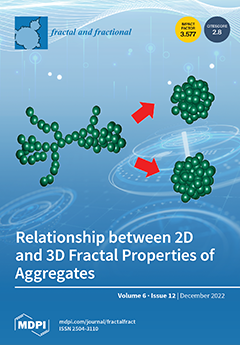The fractal dimension
has been widely used to describe the structural and morphological characteristics of aggregates. Box-counting (BC) and power law (PL) are the most common methods to calculate the fractal dimension of aggregates. However, the prefactor
, as another important fractal property, has received less attention. Furthermore, there is no relevant research about the BC prefactor (
). This work applied a tunable aggregation model to generate a series of three-dimensional aggregates with different input parameters (power law fractal properties:
and
, and the number of primary particles
). Then, a projection method is applied to obtain the 2D information of the generated aggregates. The fractal properties (
and
) of the generated aggregates are estimated by both, for 2D and 3D BC methods. Next, the relationships between the box-counting fractal properties and power law fractal properties are investigated. Notably, 2D information is easier achieved than 3D data in real processes, especially for aggregates made of nanoparticles. Therefore, correlations between 3D BC and 3D PL fractal properties with 2D BC properties are of potentially high importance and established in the present work. Finally, a comparison of these correlations with a previous one (not considering
) is performed, and comparison results show that the new correlations are more accurate.
Full article





